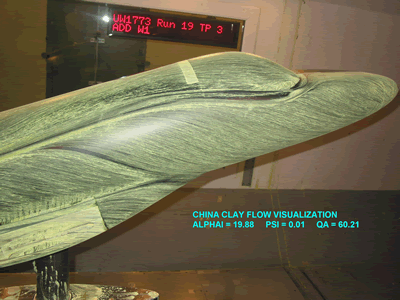Flow visualization can be used to show how the air moves over and around the model. The methods below are readily available. Other methods can be accommodated – please contact KWT. A summary of flow visualization methods is included in the table below:
Flow Visualization comparison:
| Method | Flow Vis. On Model | Flow Vis. Off Model | Photos w/ Wind-on | Photos w/ Wind-Off | Effect on Data |
|---|---|---|---|---|---|
| Smoke | Yes | Yes | Yes | No | Small |
| China Clay | Yes | No | Yes | Yes | Small |
| Minitufts | Yes | No | Yes | No | Very Small |
| Sewing Thread | Yes | No | Yes | No | Small |
| Tuft Probe | No | Yes | Yes | No | Variable |
Smoke
Using a custom-made smoke generator and probe, a stream of white smoke can be inserted anywhere in the test section by positioning the probe using the traverse rig or by hand.
Advantages: Easy setup and quick repositioning of the probe allows for viewing flow patterns around any portion of the model.
Disadvantages: Extended use fills the tunnel with smoke. The tunnel must be vented to remove the smoke before further flow visualization can be used. An oily residue is left on whatever the smoke touches. Furthermore, pressure taps must be protected to prevent clogging.

Smoke flow visualization over a wing
Tufts
There are three types of tuft flow visualization techniques readily available at KWT.
Fluorescent Minitufts: Small filaments of polyester monofilament thread soaked in a UV dye are glued to the model surface. When the wind is turned on, the minitufts move in the direction of the flow. A UV flash is used to cause the minitufts to fluoresce, making them appear larger for better visibility. (Call ahead of time if you plan to use this form o
Thread Tufts: Pieces of number 60 sewing thread are taped or glued to the model surface. When the wind is turned on the tufts move in the direction of the flow. The sewing thread can be further enhanced with UV lighting.
Tuft Probe: A probe with a single yarn tuft can be positioned anywhere in the test section with the use of the traverse rig.
Advantages: Allows flow visualization at any model position. Yarn tufts are easy to install. A tuft grid provides a view of the flow pattern over a large area. Minitufts have a negligible effect on force data. Sewing thread makes a good tuft due to its clear visibility in UV or normal light, it has smaller flow effects compared with yarn, and its ease of application compared to minitufts.
Disadvantages: Does not provide a detailed flow pattern since they are constantly moving with the air flow. Minitufts require more time to install but can be left on the model.

Fluorescent minitufts on aircraft wing
China clay
For improved visibility of the flow pattern, an ultraviolet dye can be used such that when illuminated, the DayGlo™ pigment fluoresces to cleary slow the flow pattern.
Advantages: Easiest method to setup and apply. Provides lasting flow pattern on the model for photos when the wind is off. Clearly shows flow pattern; shows flow separation well.
Disadvantages: Cannot vary model position during flow visualization. Pressure taps must be protected to prevent clogging.

China Clay Flow Visualization